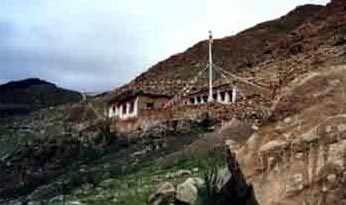|
||||||
 |
||||||
|
||||||||||||||||||||||||||||||||||||||||||||||||||||
|
|
||||||||||||||||||||||||||||||||||||||||||||||||||||
All contents of this website © 2010 Kailashzone Charitable Foundation |
||||||||||||||||||||||||||||||||||||||||||||||||||||
 |
Darchen is the base camp, located right in front of Kailash, at an altitude of 4,560 meters (14,957feet). At Dechen, tourists have a choice of accommodation, catering services and transport. The views from the base camp are much admired by visitors. To the north, is Kailash, like a glorious crystal mandala, radiating a wonderfully attractive sight at different times of the day and night. In addition, there is a permanent twinkling light from the Darchen river, which flows from the very heart of the holy mountain. To the south, there is the vast Bharka plain, full of natural beauty and containing nothing man-made. To the east, there are the Kailash mountain ranges. In the west, there are two lakes, called Manasarovar and Rashal Tal, and the giant Namo Nanyi Mountain, 50 kilometers away.
Gyangdak Monastery and the Serlung Retreat Center are situated in front of Kailash, above Darchen. It takes an hour to reach it on foot but there is also a road for vehicles. The monastery was rebuilt in 1986. Historically, it was the first monastery established at Mount Kailash and Manasarovar. Most pilgrims go on a day trip to Gyangdak and the Serlung Retreat Center. If you walk towards Kailash, you come to a waterless white lake, known as Tsokal Pa, before finally reaching the bottom of the rocky mountain, covered in snow and ice. Chaktsal Gang - Walking westward from Darchen, you come to the first of the four Chaktsal Gangs. In Tibetan, Chaktsal Gang means " peak to do prostration". Chaktsal Gangs are selected because they offer the best views of Mount Kailash. Commonly, there are piles of stones, which symbolize the offerings of the universe, and posted prayer flags, which are meant to send printed prayers of well-being to all sentient beings.
Chorten Kang Nyi - Next to Sershong Tharchen, there are two stupas, which are built like a gate. It is believed to be auspicious to walk underneath the archway formed by the two legs of this chorten. Grachom Ngagye Dorsa is one of the four sky-burial places around Mount Kailash. It is located just above Sershong Tharchen. Pilgrims go there to perform an act of death and believe that, having had sky burial there, they will be reborn in a higher rebirth in the next life. Many spill a drop of blood by pricking their finger with a needle and tearing a piece of cloth as if they were dead.
The altitude of the area is about 5,208 meters and pilgrims who are unable to walk long distances camp near Drira Pug or stay in the guest house at the monastery on the north face of Mount Kailash. The three lower hills in front of Mount Kailash are known as Manjushri, Avalokitesvara and Vajrapani, and represent wisdom, kindness and power. Starting from Drira Pug, you need to cross the wooden bridge over the Lha Chu river, which some believe is the true source of the Indus. Khado Sanglam, (Kha-do means "space-goer" and Sang-Lam means "secret path".) This path is a shortcut around Kailash and Tibetans believe it should only be taken after you have circled the mountain 12 times using the normal path. It is always covered in snow and is protected by a Dakini (goddess).
Shiva-Tsal is the second sky-burial place. There are piles of clothing here and sometimes pilgrims lie on the ground and have a Lama or monk perform the "Chod" ritual for them. Dikpa Karnak is a hole, through which pilgrims test their sin. It is believed that no matter how important you are, if you are a sinner, you face great difficulty, perhaps even death.
Shabje Drakthok. At the bottom of the Dolma Pass, there is a huge rock, on which there are footprints as if left by some angry people. Pilgrims believe the footprints are those of Milarepa and Naro Ponchung, who were arguing over which way they should go around Kailash and pulled each other in different directions. Buddhists go clockwise whereas Bon go anti-clockwise. In fact, the rock is about half way round Kailash and today other pilgrims still meet Bon pilgrims near the Shabje Drakthok. Zutul-puk Gonpa, "Cave of Miracles". The great Tibetan Yogi, Milarepa, and Bonpo master, Naro Bon Chung, used their magical powers to make a shelter as it was raining very heavily. There are foot and hand prints to see on the ceiling of the building and footprints on the roof. The current monastery was rebuilt in 1985. The main contents of the monastery are statues of Shakyamuni Buddha, Guru Rinpoche and Jigten Sumgon. A small group of monks is responsible for the monastery. Sa Ser Mar, "Yellow and Red Ground". It is believed some foreign intruders sold the Choku monastery's bronze pot and at this spot they made some tea in the pot. When their tea boiled, it was blood and pus. So they emptied the pot on the ground, which turned into those colours.
|
| Sacred
sites at the Mount Kailash | Senge
Tenzin Rinpoche | Ngari:
western Tibet | Limi: northwestern Nepal | Dolpo: eastern Nepal |




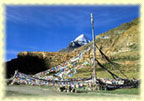




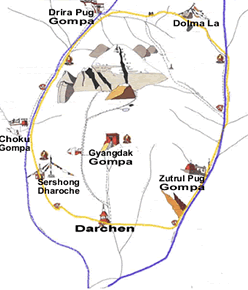
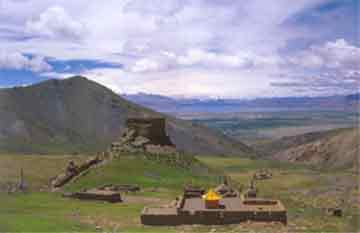
 Sershong
Tharchen - Prayer flags attached to a tall pole are called
Sershong Tharchen. Each year, on the 15th day of the fourth month
in the Tibetan calendar, the Festival of Re-adorning the Prayer
Flags is celebrated. In fact, Tibetans believe this date is the
birthday of Lord Buddha and it is thought that observing religious
practices during this month (Saka Dawa in Tibetan) accumulates one
hundred times more merit. The first Sershong Tharchen was posted
in the 17th century by Gyaden Tsewang, who liberated the three Ngari
from the occupation of the Lhadak Kingdom.
Sershong
Tharchen - Prayer flags attached to a tall pole are called
Sershong Tharchen. Each year, on the 15th day of the fourth month
in the Tibetan calendar, the Festival of Re-adorning the Prayer
Flags is celebrated. In fact, Tibetans believe this date is the
birthday of Lord Buddha and it is thought that observing religious
practices during this month (Saka Dawa in Tibetan) accumulates one
hundred times more merit. The first Sershong Tharchen was posted
in the 17th century by Gyaden Tsewang, who liberated the three Ngari
from the occupation of the Lhadak Kingdom. 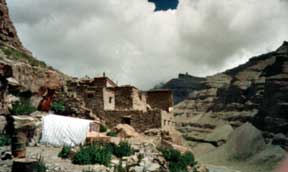 Choku
Monastery is located on a steep hillside, on the left side
of Kailash. The monastery was rebuilt in 1985. Currently, there
are three monks in charge of it. Choku monastery houses some precious
objects, which were taken to Bhutan during the Cultural Revolution,
including a marble statue of Buddha Amitabha, called Choku, a conch
shell, which originally belonged to the Indian master Naropa, a
large bronze pot, and a pair of elephant tusks. The monastery was
named after the statue of Buddha Amitabha. It is believed there
were five precious Buddha statues, which appeared out of a lake
of milk in Garsha, in the northeast of India. Three of them were
lost during the Cultural Revolution and only two remain - one in
Garsha and the other in Choku monastery.
Choku
Monastery is located on a steep hillside, on the left side
of Kailash. The monastery was rebuilt in 1985. Currently, there
are three monks in charge of it. Choku monastery houses some precious
objects, which were taken to Bhutan during the Cultural Revolution,
including a marble statue of Buddha Amitabha, called Choku, a conch
shell, which originally belonged to the Indian master Naropa, a
large bronze pot, and a pair of elephant tusks. The monastery was
named after the statue of Buddha Amitabha. It is believed there
were five precious Buddha statues, which appeared out of a lake
of milk in Garsha, in the northeast of India. Three of them were
lost during the Cultural Revolution and only two remain - one in
Garsha and the other in Choku monastery. 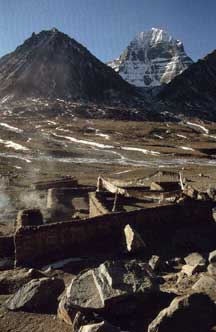 Drira
Pug is located behind Kailash and was rebuilt in 1986.
Usually there are two monks who explain the holy objects and the
history of the monastery to pilgrims and visitors. The original
monastery was founded by the first person who walked around Mount
Kailash, Gyalpa Gotsangpa. According to the history of Kailash,
Gotsangpa saw a female yak ahead of him and knew that she was an
emanation of the Dakini Sengdongma. Then she disappeared, leaving
behind a miraculous hoof-print on a rock. Gotsangpa decided to meditate
there and slowly a stone hut grow around him. The hut was named
"Drira Pug" or "Cave of the Female Yak's Hoof".
(Dri means female yak, Ra means hoof.)
Drira
Pug is located behind Kailash and was rebuilt in 1986.
Usually there are two monks who explain the holy objects and the
history of the monastery to pilgrims and visitors. The original
monastery was founded by the first person who walked around Mount
Kailash, Gyalpa Gotsangpa. According to the history of Kailash,
Gotsangpa saw a female yak ahead of him and knew that she was an
emanation of the Dakini Sengdongma. Then she disappeared, leaving
behind a miraculous hoof-print on a rock. Gotsangpa decided to meditate
there and slowly a stone hut grow around him. The hut was named
"Drira Pug" or "Cave of the Female Yak's Hoof".
(Dri means female yak, Ra means hoof.)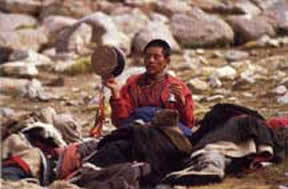
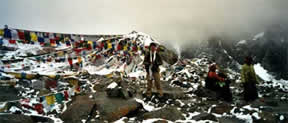 Dolma
La, at 5,630 meters, is the highest point on the path around
Kailash. There is a large rock representing Jetsun Dolma (Tara)
at the peak of the pass, where prayer flags are posted and squares
of printed paper are thrown on the ground. There pilgrims recite
prayers loudly and prostrate themselves. Then many make a fire to
burn incense and hang up new prayer flags and remove the old flags
to take home as a blessing. Tibetans wear these around their necks.
It is traditional to leave and take something - coins, butter, or
other offerings attached to the rock. Around the area, people collect
a type of grass which Tibetans call Kailash incense, "Gang
Pes".
Dolma
La, at 5,630 meters, is the highest point on the path around
Kailash. There is a large rock representing Jetsun Dolma (Tara)
at the peak of the pass, where prayer flags are posted and squares
of printed paper are thrown on the ground. There pilgrims recite
prayers loudly and prostrate themselves. Then many make a fire to
burn incense and hang up new prayer flags and remove the old flags
to take home as a blessing. Tibetans wear these around their necks.
It is traditional to leave and take something - coins, butter, or
other offerings attached to the rock. Around the area, people collect
a type of grass which Tibetans call Kailash incense, "Gang
Pes". 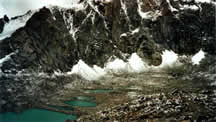 Tsokalpa is a lake half way down from the Dolma La. A Hindu story says the
lake was the swimming pool of Dakini Pranite, the wife of Lord Shiva.
A Tibetan story says a woman carrying her only child on her back
let the child fall while she was trying to drink some water. So
she renounced her worldly life and circled around Kailash one hundred
and eight times and achieved liberation.
Tsokalpa is a lake half way down from the Dolma La. A Hindu story says the
lake was the swimming pool of Dakini Pranite, the wife of Lord Shiva.
A Tibetan story says a woman carrying her only child on her back
let the child fall while she was trying to drink some water. So
she renounced her worldly life and circled around Kailash one hundred
and eight times and achieved liberation. 